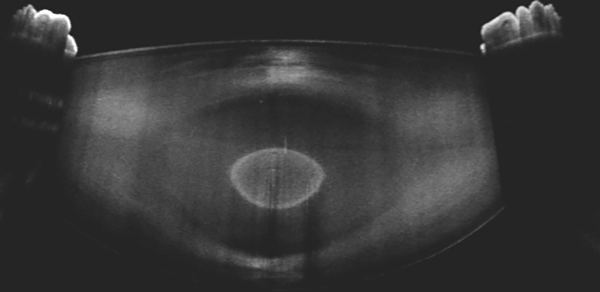
IMÁGENES CIENTÍFICAS
¿Objeto no identificado?: catarata pulverulenta congénita
Luisina Canegallo, Paula S. Maldacena, Marcos Schunk, Federico Bordon, Javier Maldacena
Centro de Ojos Paraná, Paraná (Entre Ríos), Argentina.
Recibido: 10 de julio de 2025.
Aprobado: 15 de agosto de 2025.
Autor corresponsal
Dra. Luisina Canegallo
Centro de Ojos Paraná
Paraguay 19
(3100) Paraná, provincia de Entre Ríos
Argentina
+54 (343) 431-7513
Luisinacanegallo@gmail.com
Oftalmol Clin Exp (ISSNe 1851-2658)
2025; 18(3): e397-e399.
DOI: https://doi.org/10.70313/2718.7446.v18.n3.440

En la imagen obtenida mediante tomografía de coherencia óptica de segmento anterior se puede visualizar la presencia de una opacidad bien delimitada que afecta núcleo fetal y embrionario del cristalino del ojo derecho, compatible con una catarata pulverulenta congénita. Este hallazgo es de herencia autosómica dominante que no afecta significativamente la visión y en este caso es bilateral1.
Actualmente al realizar una revisión del tema en PubMed encontramos que hay en total 43 trabajos sobre catarata pulverulenta y existen dos reportes históricos donde se mencionó por primera vez este término y se intuyó su relación hereditaria entre 1959 y 19622-3. En los últimos cinco años, sólo un trabajo indagó sobre las variantes genéticas conocidas y sumó la identificación de dos nuevas mutaciones4. Por esta razón compartimos esta imagen que podría encontrar en su consulta cualquier oftalmólogo.
Palabras clave: catarata pulverulenta, catarata congénita, catarata hereditaria autosómica dominante.
Unidentified object?: congenital pulverulent cataract
The image obtained by anterior segment optical coherence tomography shows the presence of a well-defined opacity affecting the fetal and embryonic nucleus of the right eye lens, consistent with congenital pulverulent cataract. This finding is inherited in an autosomal dominant pattern, which does not significantly affect vision and in this case is bilateral1.
Currently, when reviewing the subject in PubMed, we find that there are a total of 43 papers on pulverulent cataract and there are two historical reports where this term was first mentioned and its hereditary relationship was suspected, between 1959 and 19622-3. In the last five years, only one study investigated known genetic variants and added the identification of two new mutations4. For this reason, we wanted to share this image that any ophthalmologist might encounter in their practice.
Keywords: pulverulent cataract, congenital cataract, autosomal dominant hereditary cataract.
Objeto não identificado? Catarata pulverulenta congênita
Resumo
A imagem da tomografia de coerência óptica do segmento anterior mostra uma opacidade bem definida afetando os núcleos fetal e embrionário do cristalino do olho direito, consistente com catarata pulverulenta congênita. Este achado é autossômico dominante e não afeta significativamente a visão. Neste caso, é bilateral1.
Atualmente, uma revisão sobre o tema no PubMed encontrou um total de 43 estudos sobre catarata pulverulenta e dois relatos históricos nos quais o termo foi mencionado pela primeira vez e sua relação hereditária foi intuída entre 1959 e 19622-3. Nos últimos cinco anos, apenas um estudo investigou as variantes genéticas conhecidas e identificou duas novas mutações4. Por esse motivo, compartilhamos esta imagem, que qualquer oftalmologista poderia encontrar em seu consultório.
Palavras-chave: catarata pulverulenta, catarata congênita, catarata hereditária autossômica dominante.
Referencias
1. Ionides A, Francis P, Berry V, Mackay D, Bhattacharya S, Shiels A, Moore A. Clinical and genetic heterogeneity in autosomal dominant cataract. Br J Ophthalmol 1999; 83(7): 802-808. doi: 10.1136/bjo.83.7.802.
2. Franceschetti A, dieterle P. [Pagoda-shaped congenital fusiform cataract and its relation to central pulverulent cataract]. Bull Mem Soc Fr Ophtalmol 1959; 72: 341-351.
3. Smith EH. Hereditary pulverulent nuclear cataracts. Am J Ophthalmol 1962; 54: 123-129. doi: 10.1016/0002-9394(62)94006-0.
4. Goyal S, Singh R, Singh JR, Vanita V. Novel and known variants in GJA3 and LIM2 in congenital cataract families from North India. BMC Genomics 2024; 25(1): 31. doi: 10.1186/s12864-023-09880-7.